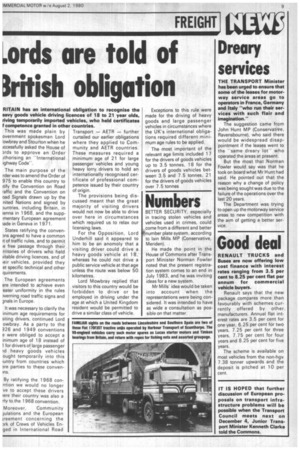iords are told of 3ritish obligation
Page 11

If you've noticed an error in this article please click here to report it so we can fix it.
R1TAIN has an international obligation to recognise the eavy goods vehicle driving licences of 18 to 21 year olds, riving temporarily imported vehicles, who held certificates I competence granted in other countries.
This was made plain by overnment spokesman Lord lowbray and Stourton when he iccessfully asked the House of )rds to approve an Order ithorising an "International ighway Code''.
The main purpose of the rder was to amend the Order of 975 to enable this country to itify the Convention on Road raffic and the Convention on oad Signals drawn up by the nited Nations and signed by )untries, including Britain, in ienna in 1968, and the suppmentary European agreement lade in Geneva in 1971.
States ratifying the conven)ns agreed to have a common it of traffic rules, and to permit le free passage through their rritories of drivers who held kelpie driving licences, and of eir vehicles, provided they et specific technical and other quirements.
The European agreements ere intended to achieve even eater uniformity in the rules werning road traffic signs and pals in Europe.
It was necessary to clarify the inimum age requirements for siting drivers, continued Lord owbray. As a party to the 926 and 1949 conventions e were obliged to accept a inimum age of 18 instead of 1 for drivers of large passenger id heavy goods vehicles ought temporarily into this ,untry from countries which ?re parties to these conven By ratifying the 1968 conntion we would no longer ye to accept these drivers iere their country was also a rty to the 1968 convention.
Moreover, Community ulations and the European ireement concerning the Drk of Crews of Vehicles Enged in International Road Transport — AETR — further curtailed our earlier obligations where they applied to Com munity and AETR countries. These measures required a minimum age of 21 for large passenger vehicles and young heavy lorry drivers to hold an internationally recognised certificate of professional competence issued by their country of origin.
The provisions being discussed meant that the great majority of visiting drivers would not now be able to drive over here in circumstances which required us to relax our licensing laws.
For the Opposition, Lord Underhill said it appeared to him to be an anornoly that a visiting driver could drive a heavy goods vehicle at 18, whereas he could not drive a public service vehicle at that age unless the route was below 50 kilometres.
Lord Mowbray replied that visitors to this country would be forbidden to drive or be employed in driving under the age at which a United Kingdom resident would be permitted to drive a similar class of vehicle. Exceptions to this rule were made for the driving of heavy goods and large passenger vehicles in circumstances where the UK's international obligations required different minimum age rules to be applied.
The most important of the relevant age limits included 17 for the drivers of goods vehicles up to 3.5 tonnes, 18 for the drivers of goods vehicles between 3.5 and 7.5 tonnes, 21 for the drivers of goods vehicles over 7.5 tonnes




























































































